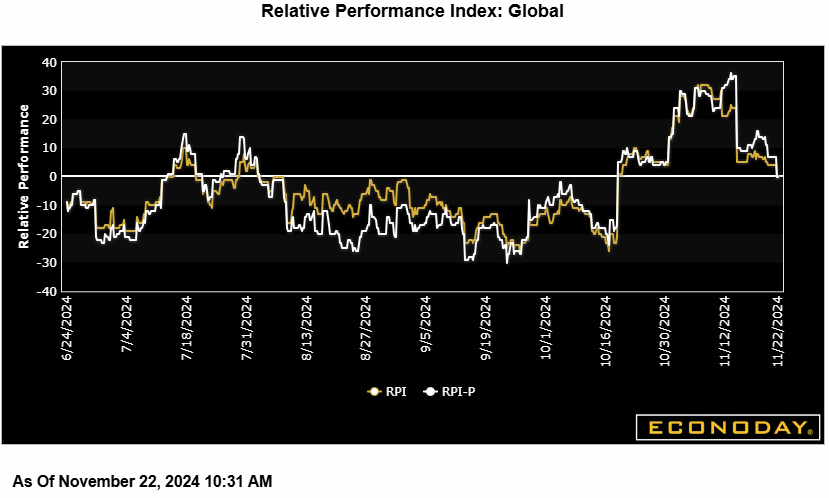Econoday’s Relative Economic Performance Index (RPI) ended the week at minus 3, indicating that recent global activity has behaved much as forecast. The U.S. continues to lead the pack ahead of Canada, but while China and Japan have offered few surprises, underperformance by the Eurozone and the UK has become more marked.
In the U.S., the latest releases were, on balance, on the firm side of market expectations and the RPI and RPI-P (both 17) were little changed on the week. Economic activity in general continues to outperform modestly, supporting Federal Reserve Chair Jerome Powell’s view that the central bank need be in no hurry to lower interest rates.
In Canada, a suite of stronger than expected data lifted both the RPI (8) and RPI-P (1) back into positive surprise territory. However, neither reading is much above zero, meaning that economic activity in general is only marginally outpacing the consensus. The reports will not dent widespread speculation about another cut in Bank of Canada interest rates in December.
In the Eurozone, early evidence of a surprisingly poor November for economic activity saw the RPI drop to minus 31 and the RPI-P to minus 44. Both values constitute 5-month lows and can only add to pressure on the ECB to ease again in December. The Governing Council is probably split between a 25 basis point or 50 basis point cut so Friday’s November flash HICP report will be all the more important.
In the UK, the RPI (minus 24) and RPI-P (minus 34) similarly slipped further below zero on the back of further signs that the economy has lost more momentum than anticipated this quarter. Even so, with October inflation surprising on the upside, the chances of another cut in Bank Rate next month have still receded.
In Switzerland, the absence of any significant market data left the RPI at minus 35 and the RPI-P at minus 25. The Swiss National Bank maintains that a December ease is not a done deal but it will take some surprisingly strong data between now and then to convince financial markets that at least a 25 basis point cut in the policy rate is not just around the corner.
In Japan, October inflation was slightly firmer than forecast but the RPI (minus 4) and RPI-P (minus 21) both lost ground and show overall economic activity falling somewhat short of market forecasts. The jury is still out on the timing of the next Bank of Japan tightening.
In China, an essentially blank data calendar made for no change in either the RPI (zero) or the RPI-P (20). If both measures can avoid falling back into negative surprise territory, it might mean that prime loan rates, which were left on hold last week, are either at, or very close to, the bottom of the current cycle.
Econoday’s RPI provides a handy summary measure of how an economy has recently been evolving relative to market expectations.
A reading above zero means that the economy in general has been performing more strongly than expected and vice versa for a reading below zero. The closer is the value to the maximum (+100) or minimum (-100) levels, the greater is the degree to which markets have been under- or over-estimating economic activity. A zero outturn would imply that, on average, the market consensus has been correct. Note too that the index is sensitized to place extra weight upon those indicators that investors consider to be the most important.


 Econoday’s Global Economics articles detail the results of each week’s key economic events and offer consensus forecasts for what’s ahead in the coming week. Global Economics is sent via email on Friday Evenings.
Econoday’s Global Economics articles detail the results of each week’s key economic events and offer consensus forecasts for what’s ahead in the coming week. Global Economics is sent via email on Friday Evenings. The Daily Global Economic Review is a daily snapshot of economic events and analysis designed to keep you informed with timely and relevant information. Delivered directly to your inbox at 5:30pm ET each market day.
The Daily Global Economic Review is a daily snapshot of economic events and analysis designed to keep you informed with timely and relevant information. Delivered directly to your inbox at 5:30pm ET each market day. Stay ahead in 2025 with the Econoday Economic Journal! Packed with a comprehensive calendar of key economic events, expert insights, and daily planning tools, it’s the perfect resource for investors, students, and decision-makers.
Stay ahead in 2025 with the Econoday Economic Journal! Packed with a comprehensive calendar of key economic events, expert insights, and daily planning tools, it’s the perfect resource for investors, students, and decision-makers.